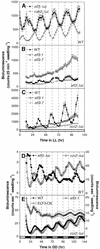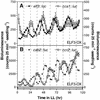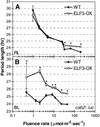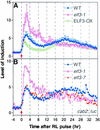ELF3 modulates resetting of the circadian clock in Arabidopsis
- PMID: 11402162
- PMCID: PMC135573
- DOI: 10.1105/tpc.13.6.1305
ELF3 modulates resetting of the circadian clock in Arabidopsis
Abstract
The Arabidopsis early flowering 3 (elf3) mutation causes arrhythmic circadian output in continuous light, but there is some evidence of clock function in darkness. Here, we show conclusively that normal circadian function occurs with no alteration of period length in elf3 mutants in dark conditions and that the light-dependent arrhythmia observed in elf3 mutants is pleiotropic on multiple outputs normally expressed at different times of day. Plants overexpressing ELF3 have an increased period length in both constant blue and red light; furthermore, etiolated ELF3-overexpressing seedlings exhibit a decreased acute CAB2 response after a red light pulse, whereas the null mutant is hypersensitive to acute induction. This finding suggests that ELF3 negatively regulates light input to both the clock and its outputs. To determine whether ELF3's action is phase dependent, we examined clock resetting by using light pulses and constructed phase response curves. Absence of ELF3 activity causes a significant alteration of the phase response curve during the subjective night, and constitutive overexpression of ELF3 results in decreased sensitivity to the resetting stimulus, suggesting that ELF3 antagonizes light input to the clock during the night. The phase of ELF3 function correlates with its peak expression levels in the subjective night. ELF3 action, therefore, represents a mechanism by which the oscillator modulates light resetting.
Figures






References
-
- Aschoff, J. (1979). Circadian rhythms: Influences of internal and external factors on the period measured in constant conditions. Z. Tierpsychol. 49, 225–247. - PubMed
-
- Crosthwaite, S.K., Loros, J.J., and Dunlap, J.C. (1995). Light-induced resetting of a circadian clock is mediated by a rapid increase in frequency transcript. Cell 81, 1003–1012. - PubMed
Publication types
MeSH terms
Substances
Grants and funding
LinkOut - more resources
Full Text Sources
Other Literature Sources
Molecular Biology Databases

